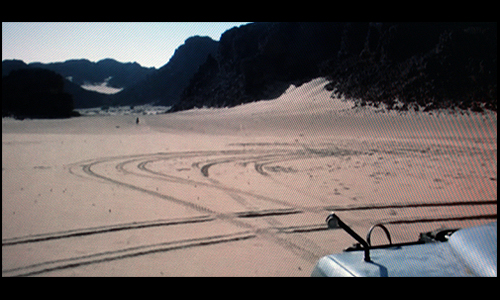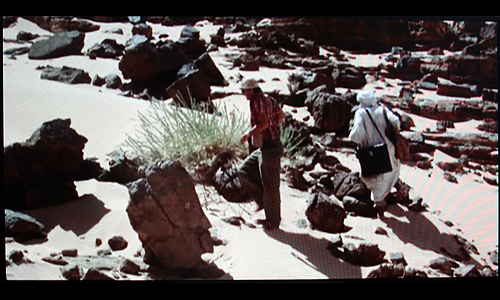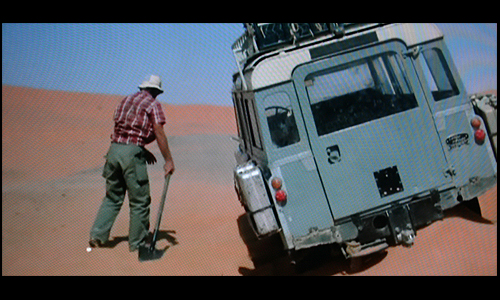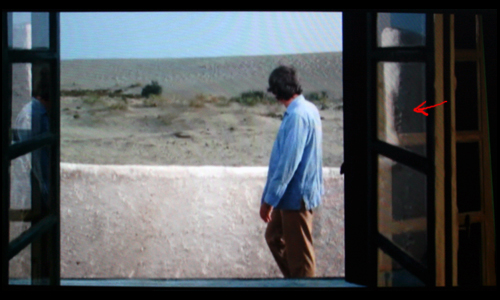In my writing on “Blow Up” I have referred to some instances of intentional pareidolia in Antonioni’s “The Passenger”, for which reason I’ll post these notes on the opening portion of that film as an example.
* * * * *

The first shot of the movie is of an impoverished Saharan town, children playing in a street to either side of which are hills covered with earthen buildings. Locke’s light blue Land Rover enters the scene. The camera is a little shaky, giving the scene a documentary feel. Locke exits the Land Rover and as the camera pulls back and pans to the left to show two boys, one in a yellow shirt, running now into the street from an alley to the side of the building, we hear him asking a woman in a yellow dress, “Can you tell me where…” The camera then returns to Locke climbing back into the Land Rover and driving off, the boy in the yellow shirt with a black band at the neck running alongside, and perhaps Locke has received directions from the woman in yellow he approached or perhaps he is receiving information from the boy who runs alongside the Land Rover, we don’t know as we see no one speak.
The license plate number of the vehicle is something like A.5471. I only note this because later, for some reason, many of the vehicles bear the same number, but a different one from this.

The Land Rover enters another scene from the left, a cock crowing so we know it is morning light, not evening, another day. Another domestic street scene of individuals sitting on a stoop. The camera pans right down the street showing the shadows of palms on the white brick facade of a building.
We hear the click of the Land Rover’s door, Locke emerging from his vehicle. Next, an interior shot facing an open door. As Locke passes through the open green door into a room populated by a few men, a young boy in a yellow shirt, who has seemingly ushered him there, steps back into the street and out of sight. The yellow shirt has a black band at the color. It is apparently the same boy who had run up to Locke in the previous encounter.
Locke having entered, several of the men promptly exit, including an individual who had been running a sewing machine. One of the two remaining individuals gestures for a cigarette, receives it from Locke, gestures for a light, then stepping outside he discretely motions for Locke to follow him, no words passing.
Another village street, the Land Rover bumping its way along. Locke exits the vehicle and, instead of remaining with him, the camera precedes him, panning left to a man seated before a fence and a woman approaching him with a blue enamel pot and cup. The man, without speaking, gestures for a cigarette and snaps his fingers urgently, as if irritated with Locke’s slowness. He pours his drink with broad gestures, as if Antonioni wishes for this to be imprinted.
Locke’s growing frustration is clearly evident. This isn’t the confidant photographer of “Blow Up” who we were shown at the beginning of that film as having successfully blended in with a number of men exiting a poor house, where he had spent the night. Thomas was jubilant, wiping dirt off his face, nearly ecstatic with that success and the anticipation of the journalistic-art photos he’d taken as opposed to his boredom with his fashion shoots.
Locke is instead clearly out of place here, a foreign anglo in the Sahara, standing out both in appearance and manner and in a sense utterly isolated though surrounded by village life scenes. His frustration here, however, is replaced by surprise, for when he returns to the Land Rover he finds seated in it a young boy in a blue and red and white striped shirt who has seemingly materialized out of nowhere. The boy stares ahead, impassive, face in profile, not turning to look at Locke as Locke looks quizzically at him. Locke asks if he speaks English and the boy doesn’t reply. Locke asks if he speaks French and the boy doesn’t reply. Locke begins to drive the Land Rover (we now view the pair from the rear in the Land Rover) and he must ask the boy which way, the boy gesturing left, but never speaking.
Now we are in the desert. The next several shots take us further and further away from humanity, finally to a point where most vehicle tracks even u-turn rather than venturing further. The white and mud colored buildings of the villages have been replaced with black rock hills.

And low and behold the boy speaks, urgently telling Locke to stop. When Locke stops the boy gets out and says something we don’t catch and neither does Locke. The boy begins walking back on foot. Bewildered, Locke asks him where he’s going. The boy doesn’t answer. This is his place of u-turn, just as with the tracks of the vehicle in the sand.
An individual is approaching from the distance on a camel. Is this someone who Locke is intended to meet? He goes to the vehicle for a cap and water jug, sits in the shade of the rear of the vehicle to drink. As the individual on the camel passes, he rises and waves at him. The individual on the camel looks at him but doesn’t respond as he rides past and away.
Now a shot from up a hill watching as the individual on the camel rides out of view behind a distant outcropping of rock, and as he does so a man emerges from a twig and grass hut on the right. The camera pans left to show the distant Locke looking up the hill, now noticing the man. They regard each other.
Next shot? Deeper into the desert still only Locke has left his Land Rover and is following the man from the hut on foot, slogging through the sand. Though he now has a guide, again his frustration is evident.
Locke asks how long it takes to get to this place and is told “12 hours, more or less.”
He asks what’s there, a camp? He’s told, yes, a sort of military camp.
“And how many people” he asks as they pass stones which seem to have distinct profiles, which I believe is not coincidental, for it was as I noted these seeming profiles that Locke asks, “And how many people?”


The response to Locke, ever abrupt, is that he will be told when they get there.
“Do they have arms?” Locke asks and is told, “They will tell you that too.” It is said that he will be told, “Everything.”
Locke and his guide are at the height of an outcropping of rock with a good view of the desert behind. Locke stumbles. His guide hears something and quickly has Locke hide in the rock with him. We see from far below on the left a caravan of seven camels enter the scene, the riders in military or police uniforms. Locke’s guide briefly eyes him with a sense of resignation then mutely, with no explanation, no farewell, climbs over the rock, leaving Locke. Locke, desperate, fearful of being left alone out here deep in the desert, anxious for his mission not to be aborted, whispers urgently, “No! No!” but the man doesn’t listen, doesn’t react to Locke’s frustration and despair. He climbs out of sight and away. Locke strikes the rock.
Next scene, Locke’s Land Rover is approaching us from the desert, on the barest vestige of road and seems to be going too fast, reckless even. And just as we note this, the Land Rover passes and the camera follows to show it immediately mired in a sand dune just to the right of the road.
The identification numbers on the back of the vehicle are gone.
Locke gets a shovel and attempts to dig himself out but he is unable to and beats the Land Rover with his shovel.

“All right!” he screams to the heavens, falling to his knees. “I don’t care!” He cries and the camera pans right over the wasteland, the only answer being the howling wind.
Next shot, Locke is walking down a village street at the edge of the desert, exhausted, near collapse with heat, thirst and his exertions. He approaches a Hotel/Restaurant/Bar. As he slams the door open, entering, we see the registration counter has tile that is broken white chips on black. I note this because we will see it echoed later, just as we will see the buildings of the village echoed in later scenes.

Exhausted, Locke passes through the blue lobby, past a painting of huts in a veritable Eden of green grass and trees which is alien to the environment. On his way to his room he asks for water. Unlocks the double yellow doors to his room and slams them shut behind him.
Now a close-up of a painted white twined cord, apparently an electrical cord, a number of black beetles making their way up it, reminding perhaps of the camels winding their way through the desert. But before we can see where the cord leads (the camera traveling up), there’s a knock on the door. A man enters not just with water but a bottle of Gordon’s Dry Gin for Locke. Locke, who is in the bathroom running his shower, calls out there is no soap. The reply is simply, “No, sir” and the individual who delivered the tray leaves the room. Locke drinks and the water still running in the shower he exits his room. Out of sight, in the hall, he knocks on another door, calling, “Robertson!” Presumably, he’s gone to look for soap…from the only individual who we learn will talk at length to him in this village.
From inside Robertson’s room, we see Locke entering. He calls out Robertson’s name again, shakes him, and we now view Robertson’s form sprawled face down on the orange blanket of the bed, a small chess set with red and white pieces to his side.
Robertson is dead. Locke has gone for soap and instead found a corpse. Locke looks around, bewildered. He shuts the door behind him. There’s perhaps a problem with continuity, Locke now attempting to turn Robertson’s body over, for the game board is now by his feet rather than his arms. Or it may not be a problem with continuity. Perhaps Antonioni planned it this way.
Robertson is bare chested, wearing white trousers. Locke pulls out from under the covers, between Robertson’s legs, Robertson’s appointment book. We see through the door into perhaps Robertson’s bathroom and is it the curtain of his shower that is waving? As if he had been preparing a shower for himself when he died, and the water has been left running? Just as Locke’s shower is running in his room? I keep thinking of this, that Locke’s shower is still running in his room. And though the motion of the curtain in the bathroom could be due some fan overhead whipping it, all of this is to be taken note of, one’s own anxieties that are roused (as in my thinking of the running water, my wondering if Robertson’s shower has been running all this time), because Antonioni has planned it this way and there will be a resolution to this question eventually, though it may not be consciously noted by the audience.
We now have a medium shot of Robertson’s face and note a vague resemblance to Locke. Music has now entered the film for the first time. It’s the lone sound of a flute. As Locke leans down to look in Robertson’s eyes, it is less like looking at a dead individual, than at another stony unresponsive face, one that enigmatically mirrors his own. Locke touches Robertson’s thinning hair.

Locke goes to the window and opens it, the flute continuing, now seeming to come from outside. He surveys the contents of Locke’s suitcase. Clothes. Belt, lighter, wallet, passport, keys. A passenger ticket book which has written on it “Munich, Box 58”. Then he notes a gun. he picks it up.
Looks over at Robertson who is now more than he had seemed, who may be a door into a world Locke has been endeavoring to enter. He takes one of Robertson’s cigarettes, contemplating the situation. He picks up a blue shirt of Robertson’s, looks up at the ceiling fan over Robertson’s head, the camera focusing only on that ceiling fan, and as the camera pans back down we now see Locke wears Robertson’s shirt. Locke calls the desk to inquire about a flight and is told the next one is in three days.
I have been thinking about that water running in Locke’s room this entire time and the individual who has answered Locke’s call is shown reaching over and turning off a water tap.
No, it is not the shower in Robertson’s room, it is not Locke’s shower, but it is a stream of running water that the individual has turned off. It is all part of the story.
That concludes also Locke in Robertson’s room. The next shot is of his exiting and locking the door, returning to his own room. We have a shot of the fan in his own room and the arches of the ceiling overhead. He is now going to switch photos in the passports. As he sits looking at the passports there is a knock on the door, but it isn’t the waiter. Instead we realize it is a flashback, Robertson’s voice entering, saying he is sorry to barge in like this but he had seen Locke’s light on and was wondering if he’d like a drink. Locke says he had seen Robertson on the plane. Robertson says this is the first time he’s been in this part of Africa and asks if Locke knows it well. Locke tells him he’s never been there before, and when he says his name, Robertson knows who he is and replies he’s often read his pieces and asks if he’s there for a story. Locke says he’s almost finished putting together pieces for a story on Africa.
We now see a tape recorder. Locke had taped this conversation and is playing back the tape.
Robertson is asking what more Locke needs and Locke says he’d like to make contact with the guerrillas. Though everybody knows they’re fighting up there, Locke says he supposes he must have taken a wrong trail.
“There aren’t very many around here,” Robertson replies.
Locke asks if he’s a journalist and Robertson says no he’s there on business. “In a god-forsaken place like this?” Locke asks as the camera pans from him to the window in what is a very famous shot, continuous shot. Robertson is saying he’s been to so many places like this over the recent years that it doesn’t make any difference anymore as he now walks into frame on the patio outside the window. He is reflected in the left window. Some sort of face, as if the face of a mask, seems as if reflected on the right. This is noticed but then it’s seen that it is instead a reflection of the white patio wall and it seems to be moving, because the window is gently moving, even as Robertson remarks how beautiful the landscape is to Locke who has entered the frame. They stand on the patio, the camera continuing to peer out the window on them.
“Beautiful, don’t you think so?” Locke asks.
“Beautiful. I don’t know.”
“So still. Kind of, waiting,” Robertson says, even as I contemplate the reflection of the patio wall, its shadows which conjure a white mask-like face, that face jumping and shaking with the shudder of the window.
“You seem unusually poetic for a businessman,” Locke replies.
“Do I? Doesn’t the desert have the same effect on you?”
“No. I prefer men to landscapes.”
“There are men who live in the desert,” Robertson replies.

The white mask-like face, composed of shadows in plaster, can be seen in the window on the right.

A detail of the shot showing the white mask-like face.
The white face in the plaster wall is purposeful. We are reminded of the black stone faces in the desert by this white plaster face here at the edge of the desert. We are reminded of all the faces which did not talk to Locke but looked past him, ever beyond him, unresponsive to him. Locke’s saying he prefers men to landscapes, and Robertson’s reply that there are men who live in the desert are signs pointing to these faces.
Because now the shot finally switches to another window, one that has a curtain of flowers. Locke is asking Robertson if he has any family as he opens the door with the flowered curtain and Robertson, passing through, replies, no, no friends, just a few commitments, “including a bad heart” and that he really shouldn’t be drinking, then asks Locke if he’d like another one and laughs.
Relationships and family are often embraced by flowers in this film.
When asked what he’ll do next, Robertson says he suspects he’ll continue on around the world, that he’s a globe trotter who takes life as it comes. He asks if it’s different for Locke, who says yes, then Robertson says that Locke must have been around quite a lot himself and Locke says yes.
We pan right from Robertson to Locke in present time switching the passport photos. On the tape recorder Robertson is laughing and saying he bets Locke has never been to Oohm Bom Bay Nay (my attempt at a phonetic spelling of the word). They laugh.
Locke looks at the tape recorder. Robertson says it’s a terrible place but airport, taxi, hotel, they’re all the same in the end. Locke replies that he doesn’t agree, “It’s us who remain the same. We translate every situation, every experience into the same old codes, we just condition ourselves.”
Robertson replies, “We’re creatures of habit.”
Locke says, “Something like that. However hard you try it stays so difficult to get away from your own habits. Even the way we talk to these people, we treat them…it’s mistaken. I mean, how do you get their confidence? Do you know?”
Robertson laughs. “It’s like this, Mr. Locke. You work with words, images, fragile things. I come with merchandise, concrete things. They understand me straight away.”
And on one level the story is about Locke’s problems as a journalist and Robertson’s relationship as a gun runner with the guerrillas but there is another level here and it has nothing to do with a country as a political unit and the strife within it. Instead there is a spiritual-psychic level, on one’s understanding of self, one’s comprehension of nature, of the environment. There is something even more mysterious than the story of the gunrunner…and Locke is wondering how to build a dialogue with it, to gain its confidence…as if how to make the rock men talk.
Locke asks where Robertson is going next and Robertson replies London, then Munich, no real reason, just thought he’d check up on some of the old places. “I haven’t been in London for three years now.”
Locke turns off the tape recorder.
Next we see him in the hall, dragging Robertson’s body on a blanket from Robertson’s room to Locke’s. With much exertion he gets Robertson on the bed. We see to the side of the bed a book on the floor, Robertson/Locke’s dead hand hanging above it. The book is Eugene Marais’ “The Soul of the Ape” with a red skull cover.
I’ve not read the book but below are a couple of paragraphs I find on it.
Marais began writing Soul of the Ape in 1916, but never finished it. It was published posthumously years later. His theory was that, unlike termites, baboons – and by extension all primates – had the ability to memorise the relationship between cause and effect. They could therefore vary their behaviour voluntarily. While termites were instinctive, the mind of baboons was based on “causal memoryâ€. The reason for this difference, according to Marais, was natural selection.
According to him, natural selection was not, like Darwin had insisted, the survival of the fittest, but rather the line of least resistance. Those species best able to adapt to their specific environment survived, while those not able to, would become extinct. Natural selection, therefore, had the tendency to both localise and specialise species.Source: http://www.encounter.co.za/article/140.html
Marais also wrote a book titled, “The Soul of the White Termite” which I’ll bring up later.
The camera moves up from the book to show “Robertson” now on that side of the bed, putting on the old Robertson’s watch.
Cut to a black and white photo of Locke’s smiling wife which has been placed on a book “…de Lumumba (?) aux colonels”.
Lumumba was an anti-colonial leader who was killed in 1961 after the deposition of his government.
It is curious that the photo of Locke’s wife rests upon this particular book.
He bends down, as if to look at the photo, but does not. One would expect him to pause upon the photo of a woman so close to him, who belongs to a life he’s leaving behind and so he must leave her as well too and put her through, presumably, some grief…unless there’s not much to grieve over.
Instead he picks up the book “The Soul of the Ape” and walks to the door. It is the only thing of his own that he takes with him. He takes a last look and leaves the room, having assumed Robertson’s identity.

He goes to the front desk and informs them the gentleman in number eleven is dead.
Note the stance of the man at the desk. Note the photo on the wall behind, of the country’s political leader.
Note too a painting of a landscape that is not on canvas but directly on the wall. It is curious. The sky of the painting is the blue of the wall, is the wall, but the rest of the landscape, its rock, the land, is painted on the wall.
And on another wall we see men and animals painted again directly on the wall, a hunting scene, reminding of rock paintings, men pursuing bulls, paintings which are not simply decorative.

I read that Antonioni chose the hotel where the final concluding scene of the movie takes place because it was once a church and was located across from a bull ring. At least that’s what I have read, and I think of the old myth of the bull, the maze, why would Antonioni want the final scene of the movie to take place across from a bull ring…
And a couple of minutes later in walks my son with a game, a maze he’s made, and he shows it off to me proudly, and talks about the picture he’s made for the background of the maze, that it is Gaul, and that one makes their way through the maze to find their way to this Gaul, the Ape King.
Leave a Reply